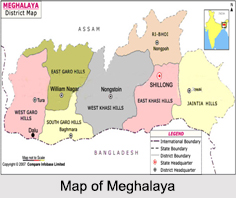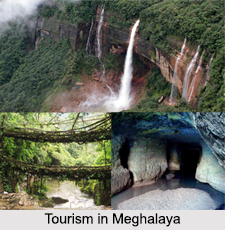 Bounded by the Indian state of Assam to the north and northeast and by the country of Bangladesh to the south and southwest, Meghalaya is a hilly state in north eastern India. Often referred to as the "abode of clouds", the state of Meghalaya separates the Assam valley from the plains of Bangladesh. The state capital of Meghalaya is the hill station of Shillong, which is located in the east central part of the state.
Bounded by the Indian state of Assam to the north and northeast and by the country of Bangladesh to the south and southwest, Meghalaya is a hilly state in north eastern India. Often referred to as the "abode of clouds", the state of Meghalaya separates the Assam valley from the plains of Bangladesh. The state capital of Meghalaya is the hill station of Shillong, which is located in the east central part of the state.
History of Meghalaya
Homeland to mainly the Garo, Khasi and Jaintia tribes, previously Meghalaya was part of Assam but emerged as an autonomous state on 21st January, 1972. This marked the beginning of a new era of geo political history of north east India. During the British rule, the imperialist authorities nicknamed Meghalaya as the `Scotland of the East` and the official language spoken there was English. Currently, the other languages spoken here include Khasi, Garo, Jaintia, Assamese and Bengali. Unlike the other Indian states, where patriarchy is at forefront, Meghalaya has historically followed a matrilineal system where the lineage and inheritance are traced through women. The youngest daughter inherits all wealth and is also supposed to take care of her parents.
Geography of Meghalaya
One of the 7 sister states of north east India, Meghalaya is a geologically rich mountainous area with stretches of valleys and highland plateaus. Consisting of Archean rock formations, there are rich deposits of valuable minerals like coal, limestone, uranium and sillimanite. The state also has plenty of rain- fed and seasonal rivers and forests, which represent the ancient eco-system and are notable for their biodiversity of animals, birds and plants.
Demographics of Meghalaya
The 7th least populous state of India, Meghalaya spreads over an area of 22,429 sq. km. The state recorded the highest decennial population growth of 27.82 percent among all the seven north eastern states, as per the provisional report of census 2011. As per these reports, the total population of Meghalaya was 2,964,007, out of which females comprised of 1,492,668 and males 1,471,339.
 The sex ratio in the state was 986 females per 1,000 males which was higher than the national average of 940. The urban female sex ratio of 985 was higher than the rural sex ratio of 972. Christians contribute 75 percent of the total population and are the largest religious community in the state followed by Hindus which contribute 12 percent along with the other religious communities, which contribute 13 percent of the total population.
The sex ratio in the state was 986 females per 1,000 males which was higher than the national average of 940. The urban female sex ratio of 985 was higher than the rural sex ratio of 972. Christians contribute 75 percent of the total population and are the largest religious community in the state followed by Hindus which contribute 12 percent along with the other religious communities, which contribute 13 percent of the total population.
Districts of Meghalaya
As of 2012, Meghalaya currently has 11 districts, 16 towns and an estimated 6,026 villages. The administration of each district is headed by a Deputy Commissioner. Few of the seven most popular districts of Meghalaya are the West Garo Hills District, East Garo Hills District, South Garo Hills District, East Khasi Hills District, Jaintia Hills District, Ri-Bhoi District and the West Khasi Hills District.
Economy of Meghalaya
Meghalaya is important for fruit cultivation, 10 percent of the total area of the state is under cultivation. Fruits cultivated include pineapples, oranges, bananas etc. The mandarin orange grown in Meghalaya is considered to be of very high quality. In addition to this, a large variety of vegetables are grown in the state including cauliflower, cabbage and radish. The important yields of the state are potato, rice, maize, pineapple, banana etc. Other crops include jute, ginger, mustard, sugarcane and chilly.
Food grains are the most important crop in Meghalaya. They occupy nearly 60 percent of the state`s cultivated area. The climatic conditions of Meghalaya allow the growth of a large variety of horticulture crops as fruits, vegetables, flowers, spices and medicinal plants. But the low level of industrialization and the poor infrastructure base acts as a barrier to the interest of the state`s economy.
Administration of Meghalaya
With a unicameral legislature, the State Legislative Assembly of Meghalaya consists of 60 members. The state has 2 representatives in the Lok Sabha; one each from Shillong and Tura. It also has one representative in the Rajya Sabha. The head of the state is the Governor who is appointed by the Government of India, the current governor of Meghalaya is Tathagata Roy. But the real executive powers are held by the Chief Minister.
Tourism in Meghalaya
The state of Meghalaya is an incredibly beautiful tourist destination and over the years tourism here has proliferated immensely. There are several national parks, wildlife sanctuaries, majestic waterfalls and some of Asia"s longest caves, which enhance the beauty of the state. The state also offers adventure tourism in the form of mountaineering, rock climbing, trekking, and hiking, caving and water sports.
Visiting Information on Meghalaya
The railway station at Guwahati is the nearest station to the state at a distance of about 189 km and the Lokpriya Gopinath Bordoloi International Airport is the closest at about 157 km from Meghalaya.






